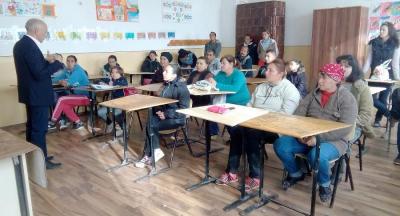Vernesti
*Disclaimer: The information and views set out in this page do not necessarily reflect the official opinion of the Council of Europe and/or the European Commission. Neither the Council of Europe, the European Commission nor any person acting on their behalf may be held responsible for the use which may be made of the information contained therein.
Vernești is a communal settlement located in the municipality of Buzău in Romania. Varnesti is the administrative centre for 11 villages. The largest Roma population can be found in the village of Cândeşti, with several groups present among them: lăutari (musicians), Roma vătraşi (settled Roma) and in smaller numbers Kalderash. The latest census cites the total population of Vernești as 8,633, 754 of which declared themselves as Roma, which represents roughly 10% of the population. It is important to note that the unofficial estimate places the Roma population at around 2,000.
Overall the education level of the Roma community is low, with approximately 17% of the community not completing primary and secondary education. 9% of the community are without and formal education. The community also face high unemployment (50% of the population are inactive) and only 33% of the population have some form of professional/vocational training. With reference to public utilities, most Roma households in Cândeşti have no access to sewage systems. Families living in segregated areas of the village (commonly referred to as “under the hill”) are in a particularly difficult situation, Roma families moved to this area some 15 years earlier. Roads here are in poor repair and suffer from constant flooding, often making them completely inaccessible.
The ROMACT Process
With the Mayor’s signature on the Letter of Commitment in February 2016, the ROMACT programme was initiated in Vernesti. A Community Action Group (CAG) was created shortly after the signing and allows a format for representative from all Roma groups to interact with the ROMACT facilitator, Mr. Calin Iosif.
The CAG, after a series of coaching session and debates, have identified the following community priorities:
| Short-term priorities | Objective 1 | Objective 2 | Objective 3 | |
|---|---|---|---|---|
| Education | Tackle the poor attendance of Roma children in kindergarten activities | |||
| Infrastructure | Reparations of roads in the village | Provide possibilities of land plots for new Roma families | Provide clean running water to the segregated area where the poorest Roma families live | |
| Health | Tackle the poor coverage of vaccination for Roma children | Tackle the risk of hepatits epidemics in the segregated area inhabited by the poorest Roma familie | ||
| Other | Hire a Roma expert within the municipality | Tackle de issue of lack of registration documents for infants |
| Long-term priorities | Objective 1 | Objective 2 |
|---|---|---|
| Housing | Solving the issue of lack of property documents | |
| Other | Setting up of a social centre | Completion of the Community Centre in Candesti |
The Municipality benefited of ROMACT expertise for the following project:
*"Integrated services for the social inclusion of the Roma community from Cândești", OPHC
Status: rejected

